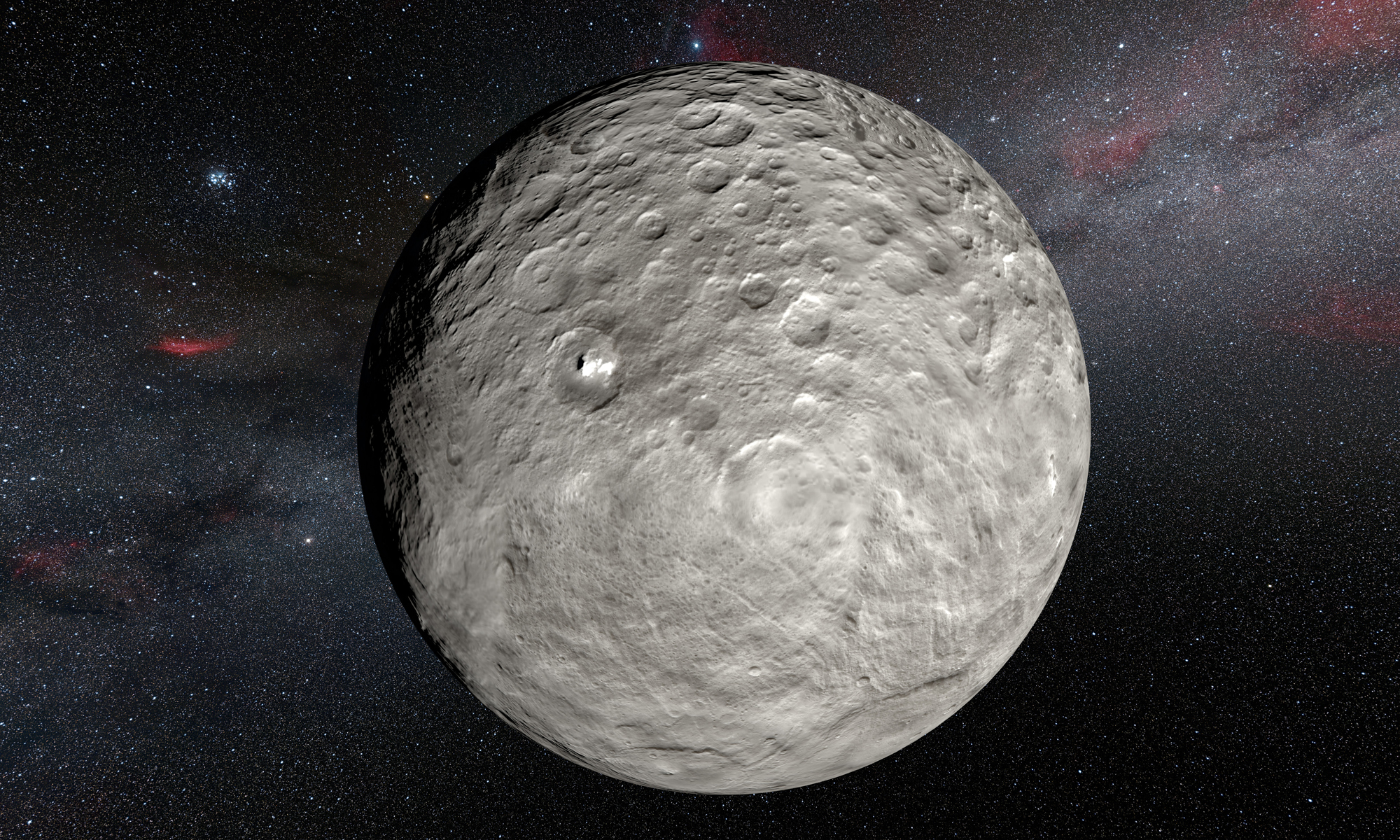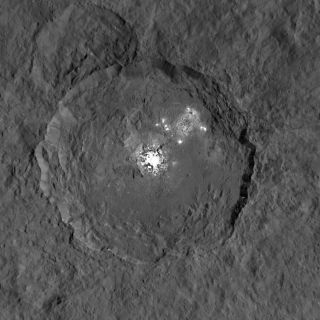Are Ceres' Weird Bright Spots Changing? What Ground-Based Telescopes Show

In 2015, NASA's Dawn space probe sent back the first images that directly revealed the presence of mysterious, bright spots on the surface of Ceres, the largest object in the asteroid belt between Mars and Jupiter. Both scientists and the general public became fascinated with these planetoid freckles.
Now, a group of scientists is using an Earth-based telescope to study the spots on Ceres and other variations on the dwarf planet's surface. Their results seem to support the idea that sunlight may regularly turn ice into vapor in the Occator crater (where the spots are located).
But, the findings also show that the rate of change from ice to vapor may be irregular, and doesn't match up perfectly with Ceres' day-night cycle. These early findings also indicate that similar observations could be used to study the dwarf planet when the Dawn probe finishes its mission. [Video: Zoom In On Ceres' Strange Bright Spots]

Studying Ceres from Earth

The Hubble Space Telescope studied Ceres long before the Dawn probe arrived there in March 2015. But Ceres is so small, faint and distant that even Hubble couldn't provide highly detailed images of the rocky landscape. Hubble did detect a variation on the surface where the bright spots turned out to be, but only Dawn could provide those gorgeous snapshots and reveal that the bright spots are most likely made of hydrated magnesium sulfates (known on Earth as Epsom salt).
Ceres is too far away for a ground-based telescope to see it the way Dawn does. But scientists are good at getting around those kinds of obstacles, and gathering information in indirect ways.
Case in point: New research shows that by using a ground-based telescope to study the sunlight that is reflected off Ceres' surface, and comparing it to the dwarf planet's rotation speed, it's possible to gather information about surface features on Ceres.
It may sound a bit convoluted, but this approach relies on a very basic principle of physics called Doppler shift, which shows that as a wave moves toward an observer, it gets compressed, giving it a slightly higher frequency. As a wave moves away from an observer, it gets stretched out, giving it a lower frequency. That's why when an ambulance is headed toward you, its siren seems to have a higher pitch, and when the siren is headed away from you, its pitch sounds lower.
Get the Space.com Newsletter
Breaking space news, the latest updates on rocket launches, skywatching events and more!
As Ceres turns on its axis, one side of it rotates toward the Earth, while the other rotates away. As a result, the sunlight bouncing off its surface experiences Doppler shift — on one side, the waves get stretched, and on the other they get compressed.
The degree to which the light gets compressed or stretched depends on how fast Ceres is rotating (just as the speed of an ambulance will determine how much higher or lower the pitch of the siren sounds), which means measuring the Doppler shift can reveal Ceres' rotation speed.
But there's a catch: slight shifts in the frequency of the reflected sunlight can also be caused by variations on Ceres' surface. Through some very careful work, a group of scientists think they have demonstrated for the first time that this technique can be used to study daily changes on Ceres' surface long after Dawn retires.
Changes on the surface of Ceres
The new work was done using the HARPS instrument at the European Southern Observatory's (ESO) La Silla Observatory in Chile. The researchers say they have successfully demonstrated that the technique can accurately measure Doppler shifts in the light reflecting off Ceres' surface and from its bright spots. Using previous measurements of Ceres' velocity (via other methods), the team showed that it is picking up changes in how much sunlight bounces off the surface — meaning, most likely, something is changing on the surface of Ceres.
"The result was a surprise," Antonino Lanza, a co-author on the new study and an associate astronomer at the Italian National Institute for Astrophysics' Catania Astrophysical Observatory, said in a statement from the ESO. "We did find the expected changes to the spectrum from the rotation of Ceres, but with considerable other variations from night to night."
At about the same time that Lanza and colleagues were preparing their work for publication, another group published work based on data gathered by Dawn, showing that icy materials in or near the shiny bright spots are likely turning straight into vapor as they are heated by sunlight, and then they are cooling back into ice when the spots face away from the sun. In general, vapor would reflect sunlight differently than pure ice, and other variations in the phases of the surface materials could lead to changes in the reflected brightness as well. Therefore, Lanza and colleagues conclude that it's possible that the findings reported in the new paper are connected to those separate observations made using data from Dawn.
However, the authors of the paper caution that this is an interpretation of their findings, and not a concrete conclusion. Paolo Molaro, lead author of the new study and a researcher at the INAF Trieste Astronomical Observatory, told Space.com in an email that, for the moment, they can only confirm that they have detected changes in the reflectivity of Ceres' surface. They can't say for sure, yet, what is causing it. And, scientists need further observations by Dawn to find out if those vapor/ice cycles are in fact happening near the bright spots.
"The Dawn pictures are much more informative and it is up to them to investigate the nature of [these] mysterious spots," Molaro wrote. "But … our technique is a new one and never attempted before because it requires very precise measurements. Our technique will be very useful when the space mission [is] finished."
It's also important to note that the new finding doesn't show a regular change in reflectivity with each full rotation of Ceres. The results suggest that the freezing and unfreezing could take more than one day-night cycle to complete, and that the variability in reflectivity may change over a period of days or even months.
The new work demonstrates that a ground-based telescope could potentially "monitor the daily activity in Ceres that can continue also beyond the [Dawn] mission," the researchers said in the new paper. Even if a ground-based telescope can't provide those jaw-dropping photos, it might serve as a valuable tool for studying Ceres in the future.
Follow Calla Cofield @callacofield.Follow us @Spacedotcom, Facebook and Google+. Original article on Space.com.
Join our Space Forums to keep talking space on the latest missions, night sky and more! And if you have a news tip, correction or comment, let us know at: community@space.com.

Calla Cofield joined Space.com's crew in October 2014. She enjoys writing about black holes, exploding stars, ripples in space-time, science in comic books, and all the mysteries of the cosmos. Prior to joining Space.com Calla worked as a freelance writer, with her work appearing in APS News, Symmetry magazine, Scientific American, Nature News, Physics World, and others. From 2010 to 2014 she was a producer for The Physics Central Podcast. Previously, Calla worked at the American Museum of Natural History in New York City (hands down the best office building ever) and SLAC National Accelerator Laboratory in California. Calla studied physics at the University of Massachusetts, Amherst and is originally from Sandy, Utah. In 2018, Calla left Space.com to join NASA's Jet Propulsion Laboratory media team where she oversees astronomy, physics, exoplanets and the Cold Atom Lab mission. She has been underground at three of the largest particle accelerators in the world and would really like to know what the heck dark matter is. Contact Calla via: E-Mail – Twitter